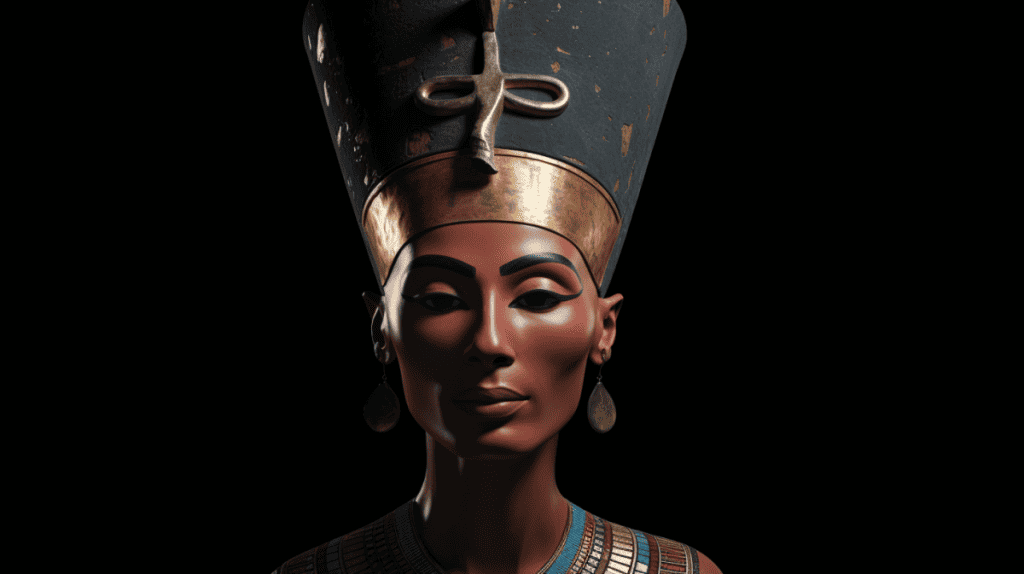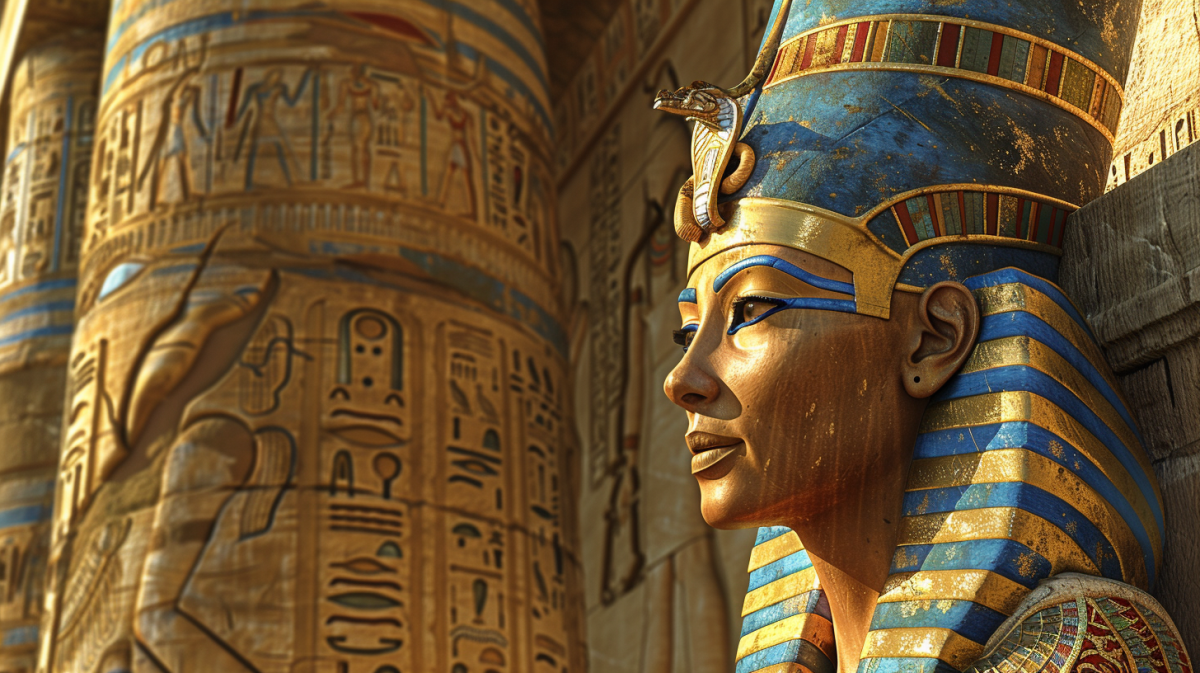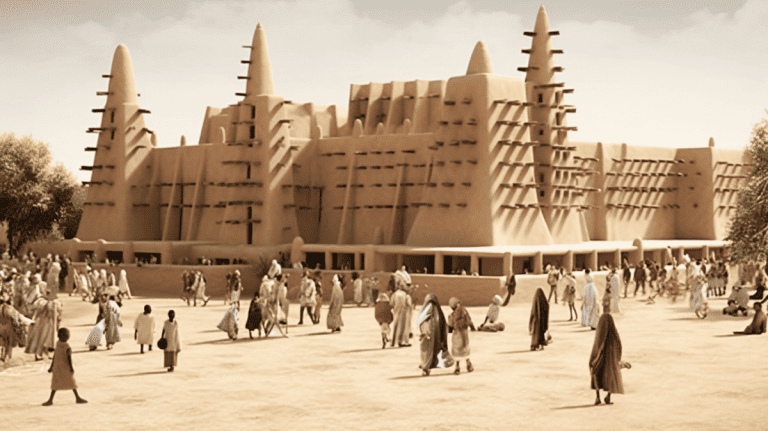Nefertiti, an Egyptian queen from the 14th century BCE, is renowned for her beauty and power during the Amarna Period. Married to Pharaoh Akhenaten, she played a pivotal role in the shift to monotheism. Her limestone bust, found in 1912, is a symbol of ancient Egyptian elegance and resides in Berlin’s Neues Museum.

There exists a school of thought among esteemed scholars, who dare to venture into the realm of conjecture, suggesting that Nefertiti, in the wake of her husband’s passing and preceding the ascension of Tutankhamun, may have briefly assumed the mantle of power as Neferneferuaten. Yet, the veracity of this claim is fiercely contested, causing ongoing debates that fuel the fires of curiosity. If, by some remarkable twist of fate, Nefertiti did indeed ascend to the throne, her reign would have witnessed the glorious downfall of Amarna and the grand return of the capital to the hallowed city of Thebes, steeped in tradition and history.
Family
Shrouded in an aura of mystery, Nefertiti’s past remains a tantalizing enigma, with only faint echoes reaching us. Before her fateful union with Akhenaten, the details of her life are veiled in obscurity. Whispers from the noble tombs of Amarna allude to a sister, Mutbenret, whose name dances amidst the ancient inscriptions. A woman of great significance named Tey emerges, bearing the weighty title of “Nurse of the Great Royal Wife,” while her husband, Ay, assumes the mantle of “God’s Father.” In the realm of Egyptology, some dare to speculate that Ay, a figure of immense influence, may have been Nefertiti’s father, yet this proposition rests on tenuous grounds. The whispers fall silent, for the sources neither confirm nor deny Ay’s parental ties to Nefertiti. Nonetheless, Ay’s looming presence during her life and beyond lends credence to the notion of a familial bond.
Another conjecture swirls within the depths of history, asserting Nefertiti’s kinship with Akhenaten as siblings. However, her illustrious titles lack the distinctive markers of “King’s Daughter” or “King’s Sister,” traditionally bestowed upon the blood relations of pharaohs. An alternate hypothesis, borne on the wings of support, weaves a tale of Nefertiti entwined with the Mitanni princess Tadukhipa. Anchored by the significance of Nefertiti’s name, evoking the arrival of a beautiful woman, some scholars propose a foreign lineage. Yet, the union of Tadukhipa with Akhenaten’s father and the absence of tangible evidence for Nefertiti’s non-Egyptian roots cast shadows of doubt upon this narrative.
Amidst the haze of uncertainty, the chronicles falter in defining the precise union between Nefertiti and Akhenaten. The dates elude us, slipping through the fingers of time. We glimpse a glimpse of their shared existence in the form of their daughters, at least six in number. Meritaten, Meketaten, Ankhesenpaaten, later known as Ankhesenamun upon her union with Tutankhamun, Neferneferuaten Tasherit, Neferneferure, and Setepenre, these princesses etched into the annals of history. Nefertiti, once contemplated as the mother of Tutankhamun, succumbs to the scrutiny of genetic study, which casts doubt upon such lineage.
Life of Nefertiti
Fragments of Nefertiti’s life story linger in the annals of time, mere glimpses into a captivating tale. The precise dates that bookend her existence elude us, lost in the folds of history’s veil. From the hallowed courts of ancient Egypt, Nefertiti emerged, her lineage shrouded in mystery, a diamond in the rough, yet destined for greatness. As a child, she was cradled in the opulence of the royal court, a witness to the resplendence and grandeur of Pharaoh Amenhotep III’s enduring reign. Egypt, under his prosperous rule, stood as a bastion of wealth and security, casting its radiant light upon Nefertiti’s formative years.

In the bloom of her youth, Nefertiti entered the sacred union of matrimony, her tender heart bound to the heir of the throne. The whispers of time debate her age, some suggesting she may have been but a flower bud, blooming before her time. Amenhotep IV, the successor to his father, ascended to the throne, bearing the weight of leadership in his mid-20s or early 30s. And in the fourth year of his reign, the stars aligned, entwining their fates as Nefertiti assumed her rightful place, adorning the illustrious title of the great royal wife.
Marriage to Amenhotep IV
From the ancient city of Achmim, nestled in the heart of Middle Egypt, emerged the families of Tey and Ay, whose destinies intertwined with the fateful threads of history. Achmim also cradled the roots of Tiye, the revered wife of Pharaoh Amenhotep III, their shared heritage forging a connection between their lives. Within this intricate tapestry, it comes as no surprise that Tiye, guided by an unseen hand, chose Nefertiti to be the bride of her beloved second son, Amenhotep, who would later assume the name Akhenaten.

The precise details of this union, whether it transpired before Amenhotep IV’s ascent to the throne in the year 1351 BC or the tender age of Nefertiti at the time, elude the grasp of recorded history. In an era where royalty often wed at tender ages, and with Amenhotep IV himself no more than a youth of 16 to 18 during his coronation, it is likely that Nefertiti, like a blossom unfurling, was somewhere between the tender years of 12 and 16.
As the sun cast its radiance upon the nascent years in Thebes, the city witnessed the blossoming of Akhenaten, still known as Amenhotep IV. Amidst the sacred precincts of Karnak, temples rose to honour the divine, and among them stood the resplendent Mansion of the Benben, a sanctuary dedicated to Nefertiti herself. In the artistry of the ages, Nefertiti, accompanied by her daughter Meritaten, graced the scenes, their ethereal presence immortalized. Even amidst the talatat, the fragile stone blocks that whisper tales of antiquity, Nefertiti’s image emerges, eclipsing even her husband’s prominence. She stands as the pillar of support, faithfully positioned behind the pharaoh, offering her unwavering devotion. But the artistry transcends the boundaries of tradition, for Nefertiti assumes roles reserved for kings alone. She smites the enemy with righteous fury and captured foes adorn her regal throne, a testament to her unyielding power and command.
In the shadows of ancient Egypt’s grandeur, the story of Nefertiti unfolds, a tale of strength, regality, and a queen who defied the boundaries of convention.
A Family Altar From Akhetaten
In the dawning of his fourth year as pharaoh, a seismic decision stirred within the heart of Amenhotep IV. With resolute determination, he commanded the capital to shift, casting aside the familiar embrace of tradition for the untamed allure of Akhetaten, now known as Amarna. As the fifth year unfurled its vibrant tapestry, a transformation was ordained, and Amenhotep IV shed his old name, emerging as Akhenaten, a beacon of the sun’s divine radiance. Alongside this metamorphosis, Nefertiti, his beloved queen, embraced her rebirth as Neferneferuaten-Nefertiti, an emblem of their devotion to the venerated cult of the Aten. With this celestial shift, the very fabric of Egypt’s religious fabric was rewoven, transcending the bounds of polytheism into a realm akin to monolatry or henotheism, where one god, though not sole, commanded devotion.

In the grand design of Akhenaten’s new religion, Nefertiti stood as an indispensable pillar. Her elevated stature matched her husband’s, their union forged as coequals in the worship of the resplendent Aten, the sun god. Honor was bestowed upon her with an intensity unparalleled in Egypt’s storied history, surpassing the regal acclaim of any queen before her. A temple, a testament to her sacred influence, graced the land, a testament to her divine connection. In the sacred bond of their union, their daughters manifested, borne upon the wings of celestial blessing. Meritaten, the first of their children, emerged into the world, followed by five sisters, each embodying the profound union between their mortal existence and the celestial Aten, the sole object of Egypt’s devotion. As artistic renderings of the royal family emerged, the sun’s rays cascaded upon them, an ethereal benediction.
Within this radiant tapestry, Nefertiti ascended to a status unparalleled in Egyptian annals. Her visage adorned art, statuary, and buildings, etching her presence indelibly upon the tapestry of history. She, above all, became the guiding light, the chief priestess, and the muse who breathed life into Akhenaten’s ideological pursuits. As the religious tides surged, Nefertiti’s name too underwent a transformation, bearing the weighty title of Neferneferuaten Nefertiti—a proclamation of her beauty that had arrived in the realm of the Aten, the beacon of divinity.
In the famed family altar, now nestled within the revered halls of the Ägyptisches Museum, a vivid tableau unfolds. The royal couple, joined by their three eldest daughters, basks in harmonious bliss, bathed in the resplendent rays of Aten. Yet, beneath this celestial embrace, a testament to Nefertiti’s status emerges. She stands at an equal scale to her husband, her name enshrined alongside Akhenaten and the god Aten within the royal cartouche. The hands that extend from the rays of divine light bear the ankh symbol, bestowing it with equal reverence before the faces of both king and queen.
One particular detail from this revered altar bolsters the belief that Nefertiti held political status equal to, if not surpassing, Akhenaten himself. The embellishment adorning her chair depicts the sacred “Unification of the Two Lands,” symbolized by a knot that binds the lotus and papyrus, representing Upper and Lower Egypt. This symbol, an emblem of unity, is customarily reserved solely for the reigning monarch.

In the hallowed tombs of Huya and Meryre II, ancient inscriptions etched into the stone walls unveil a remarkable tribute to Akhenaten and Nefertiti. Dated to Year 12, during the second month of Peret, on the eighth day, a grand procession materializes before their regal presence. From distant lands, the people of Kharu in the north and Kush in the south converge, bearing precious offerings of gold and revered treasures. A foreign magnificence cascades upon the couple, an acknowledgement of their divine status, their influence resonating far beyond the borders of Egypt.
In the hallowed embrace of Meryre II’s tomb, a scene unfolds, capturing the essence of royal bliss. Akhenaten and Nefertiti, seated within an opulent kiosk, bask in their sovereign majesty, while their six daughters, blessed embodiments of their sacred union, surround them. Within this tableau of familial serenity, a fragile presence lingers—the graceful princess Meketaten, captured for eternity, her light dimmed too soon.
Amidst the grandeur and celestial worship, the story of Nefertiti and Akhenaten weaves a tale of divinity entwined with mortal love. They stood as beacons, illuminating the path of Egypt’s religious transformation, guided by the radiant Aten. Their journey, etched in art and inscriptions, resonates across the aeons, forever immortalizing their profound impact on the history of the ancient world.
Possible Reign as Pharaoh
In the depths of time, Nefertiti’s presence vanishes from the annals of history, fading into a shroud of uncertainty around the twelfth year of Akhenaten’s reign. Did she succumb to the embrace of mortality, her radiance extinguished, or did a remarkable fate befall her? Whispers weave through the corridors of speculation, hinting at the possibility that she, in a moment of unprecedented power, became her husband’s co-regent, adorned with the illustrious name Neferneferuaten. The echoes of a remarkable queen linger, for the path of history has witnessed extraordinary transformations before. In the bygone fifteenth century B.C., the indomitable pharaoh Hatshepsut donned the mask of a man, a ceremonial false beard adorning her visage as she guided Egypt under her rule.

If Nefertiti retained her dominion during the twilight years of Akhenaten’s reign and beyond, it is conceivable that she embarked upon a journey to rectify her husband’s religious policies, a reversal that would bear fruit in the reign of the young King Tut. Neferneferuaten, the name whispered in reverence, sought solace in divine offerings to Amun, beseeching his return to dispel the encroaching darkness that shrouded the kingdom.
Should Nefertiti have ascended to the throne as Pharaoh, a tapestry of theories envisions her orchestrating a meticulous campaign of damage control. With grace and cunning, she may have sought to reinstate the ancient Egyptian religion, honouring the Amun priests and guiding Tutankhamun along the path of tradition, where the gods of old held sway.
Across the ancient sites that bear the weight of time’s passage, Nefertiti stands resolute, a figure of unparalleled stature. She strides as an equal to kings, her regal form smiting Egypt’s enemies, a symbol of power and sovereignty. On chariots, she rides with unyielding grace, and in the sacred realm of worship, she adores the Aten with the reverence befitting a pharaoh.
Among the eminent voices of archaeology, Dr Zahi Hawass lends his wisdom to the tapestry of speculation. From the fragments of Tutankhamun’s tomb, he deciphers the presence of ushabti and feminine evidence, whispers of a female pharaoh, a resurgent Nefertiti returning to Thebes from Amarna, reclaiming her mantle of rulership. In the grand narrative of Egypt’s storied past, the tale of Nefertiti shines on an enigmatic queen who defied convention and etched her name upon the sands of time.
Death of Nefertiti
Old Theories
The veiled mysteries of ancient Egypt once whispered tales of Nefertiti’s disappearance from the historical tapestry, a silence that enveloped her existence around the twelfth year of Akhenaten’s reign. The enigmatic void left Egyptologists grappling with a myriad of possibilities, weaving tales of injury, the merciless grip of a devastating plague, or the call of nature’s inexorable cycle. Fragmented remnants, in the form of ushabti fragments, bearing Nefertiti’s name, found solace in the hallowed halls of the Louvre and the Brooklyn Museum, their silent testimony to a queen lost.
Once, a discredited theory dared to suggest that Nefertiti had fallen from grace, banished to obscurity. Yet, deliberate erasures etched upon monuments belonging to the queen of Akhenaten unveiled a different truth, one that pointed to Kiya, not Nefertiti. The shattered illusions led to a revised understanding, yet the lingering question of Nefertiti’s fate remained.
Within the realm of Akhenaten’s reign, a breathtaking transformation unfolded, for Nefertiti basked in the radiance of unprecedented power. Whispers echoed of her ascent, her status elevated to that of co-regent, standing equal to the pharaoh himself, as immortalized in the vivid strokes of the Coregency Stela.
Perhaps, within the realm of possibility, Nefertiti donned the mantle of Neferneferuaten, a regal ruler shrouded in the mists of time. The veiled theories posit her continued presence, her influence weaving through the corridors of the younger royals. Yet, if this was her destiny, the echoes of her reign would have faded, entwined with the third year of Tutankhaten’s rule, an epoch where he emerged anew as Tutankhamun. This profound shift signified a return to the sacred embrace of Amun, a solemn abandonment of Amarna, as the capital yearned to reclaim its soul within the heart of Thebes.
The enigmatic tale of Nefertiti, forever intertwined with the shadows of Egypt’s past, leaves us yearning for answers that lie buried beneath the sands of time.
New Theories
In the transformative year of 2012, a revelation emerged from the ancient depths, an inscription etched upon the fabric of time. Carved within Quarry 320, nestled in the majestic expanse of the limestone quarry at Dayr Abū Ḥinnis, it spoke of a momentous truth. With strokes of red ochre, five lines painted an indelible image, a testament to the presence of the illustrious “Great Royal Wife, His Beloved, Mistress of the Two Lands, Neferneferuaten Nefertiti.” The very essence of her being echoed through the ages, her name written in eternal script.
Within the tapestry of this inscription, a revelation unfolded an irrefutable truth that shattered the veil of uncertainty. In the sixteenth year of Akhenaten’s reign, their thrones remained united, their presence as powerful as in the earliest days of their rule. The authority of the king’s scribe Penthu extended over the ongoing construction of the Small Aten Temple in Amarna, a testament to the vibrancy of their reign.
The profound implications of this discovery demand a paradigm shift, as van der Perre emphasizes. It unveils the irrevocable truth that Akhenaten and Nefertiti stood side by side, breathing life into their kingdom. Their presence, resolute and unyielding, reverberated in the second-to-last year of Akhenaten’s reign, leaving no room for doubt. The reign of Neferneferuaten, the enigmatic female pharaoh, emerged as a crucial interlude between the passing of Akhenaten and the rise of Tutankhamun. In the annals of history, she adorned her cartouches with the epithet “Effective for her husband,” an enchanting declaration that intertwines the possibilities of Nefertiti herself or her daughter Meritaten, who shared her life with the enigmatic king Smenkhkare.
The threads of ancient Egypt’s narrative are woven with layers of intrigue and awe, where the fate of Nefertiti dances with the veil of time. Her presence, her power, and her connection to the divine remain etched upon the eternal canvas of history, forever beckoning us to uncover the untold truths of her reign.
KV21B Mummy
Within the sacred depths of KV21, a chamber steeped in mystery and ancient whispers, a revelation emerges—the discovery of two female mummies, veiled in the shroud of time. Among them, a tantalizing possibility arises, an ethereal connection to the enigmatic figure of Nefertiti. A quest ensues, fueled by the yearning to unravel the secrets that lie entwined within their earthly remains. The sacred veil of DNA analysis, though lacking definitive certainty, sheds a glimmer of light, confirming their membership within the revered lineage of the Eighteenth Dynasty.
As the ancient mummy, cautiously cradled in the embrace of CT-scanning, surrenders its secrets, a portrait of Nefertiti begins to materialize. Her age at the time of death, the tender imprint of time’s passage, rests upon her form, whispering that she had lived for approximately 45 years. A poignant detail reveals itself—the gentle curve of her left arm, lovingly draped over her chest, an eternal pose befitting a queen. The tantalizing possibility arises, for in the shadowy confines of the tomb, a connection is woven, linking her to the mummy provisionally identified as Ankhesenamun. Just as Tiye and the Younger Lady, mother and daughter, lay together in KV35, the very essence of kinship may have united these mummies in eternal repose.
In the sacred embrace of KV21, the enigma of Nefertiti dances with the spirits of the past. The mummies, silent guardians of an ancient legacy, beckon us to gaze beyond the veil and seek the truth that lies within. Though shrouded in uncertainty, their presence whispers a tale that intertwines the royal lineage, a delicate thread connecting generations across the timeless expanse of Egyptian history.
Related Posts
Sources
- “Nefertiti.” Wikipedia. Accessed July 5, 2023. https://en.wikipedia.org/wiki/Nefertiti.
- “The Queen – Nefertiti.” Staatliche Museen zu Berlin. Accessed July 5, 2023. https://www.smb.museum/en/museums-institutions/aegyptisches-museum-und-papyrussammlung/collection-research/bust-of-nefertiti/the-queen/#:~:text=Nefertiti%20was%20the%20principal%20wife,status%20and%20death%20are%20scarce.
- “Religion of the Aton.” In Akhenaten. Britannica. Accessed July 5, 2023. https://www.britannica.com/biography/Akhenaten/Religion-of-the-Aton.
- “Nefertiti.” History.com. Accessed July 5, 2023. https://www.history.com/topics/ancient-egypt/nefertiti.
- “Nefertiti Was More Than Just a Pretty Face.” National Geographic. Accessed July 5, 2023. https://www.nationalgeographic.co.uk/history-and-civilisation/2022/03/nefertiti-was-more-than-just-a-pretty-face.





